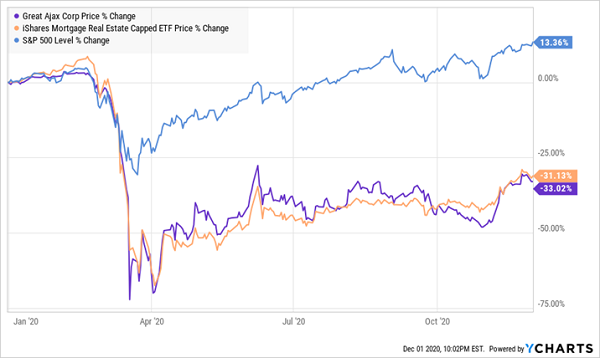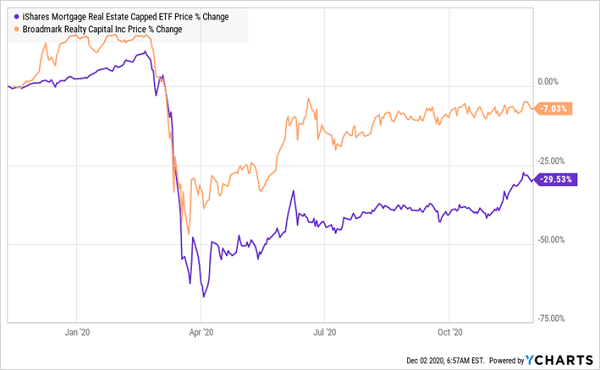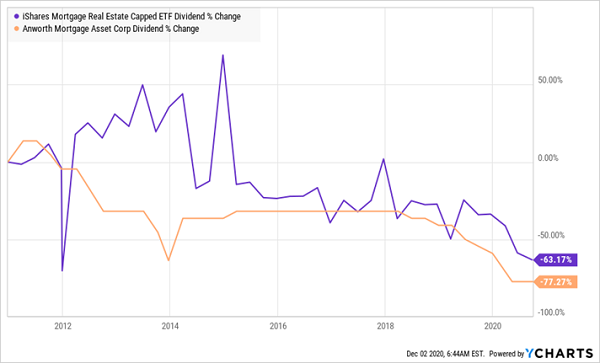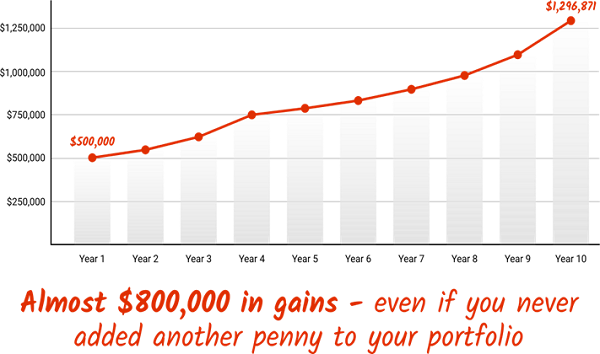When April 1 rolled around, many mortgage payments were made late. That was no joke—we were in the midst of our first (and most serious) round of lockdowns.
Who knew what bills were going to get paid, if any?
Mortgage REIT (mREIT) stocks, which require mortgages to actually be paid, suffered broadly and badly. Some shares, such as industry bellwether Annaly (NLY), dropped as much as 60% in just more than a month. This plunge crushed many income investors, who rely on the fat dividends paid by the sector (11.2%, on average!) to fund their retirements.

Now, mREITs don’t actually own or operate any real estate (unlike their REIT cousins). The similarity is in the tax status—neither pays taxes on their profits provided they dish most of their income as dividends to their investors, Hence, the fat yields for REITs and downright gluttonous payouts for mREITs.
These “paper REITs” can deliver high-single digit and even double-digit dividend yields without breaking a sweat, making mREITs—like the three I’m about to break down for you today—worth a regular look for any serious income investor.
I have mREITs on the brain after my recent post covering stocks that can beat the market almost entirely in dividends. The mREIT I discussed there—the nation’s largest, with an uncommonly flexible business model—left me jazzed about the space, so I decided to put on my research hat to see if I could unearth any other high-income gems.
Good news there: There is indeed some potential (and dividends) we can squeeze out of this space.
And thanks to COVID pressures, mREITs are trading at much better valuations than they have in years. Credit Suisse researchers say commercial REITs are trading at an average yield of 10.5% versus a historical average of 9%. That might not sound like much, but an additional 1.5 percentage points in yield is an extra $7,500 in annual dividend income on a modest $500,000 retirement nest egg!
But let’s tread carefully here. The mREIT industry is notoriously difficult for stock pickers, and the absolute highest yielders frequently turn into dividend traps. So let’s explore the following three mREITs with not just an eye toward income, but an eye toward quality so we know these payouts will last.
I think they are all in the same boat—interesting stocks to trade if you can time them right (a big if), but not buy and holds for any length of time.
Great Ajax (AJX)
Dividend Yield: 6.9%
Great Ajax (AJX) is a wide-ranging mREIT that acquires, invests and manages mortgage loans secured by single-family residences and properties, as well as loans secured by multi-family residential and commercial mixed-use properties. On top of all that, it owns some single-family homes and smaller commercial properties.
Diversification is great, though it hardly stopped AJX from hitting the wall during the February-March downturn.
Great Ajax Spiraled the Drain With the Rest of the Industry

Net income plunged from 31 cents per share to just 2 cents, primarily because of loan-loss provisions based on expectations of fallout from the COVID-19 outbreak. The mREIT was forced to hack away at its payout, too, dropping its May dividend 47% to 17 cents per share, where it has remained since then.
But operations are recovering. The company’s most recent EPS of 23 cents per share were a little better than Wall Street was hoping for. Management said there’s plenty of room for interest expenses to come down, which would further bolster its profits going forward. AJX also has plenty of excess capital it could put to work on cheap assets.
And Ajax is going to need to do exactly that; its still-depressed earnings don’t warrant much more stock movement from here. Investors also need to hope for serious dividend restoration going forward, because otherwise, they’re collecting extremely below-average dividends in an industry that hasn’t produced much growth in years.
Broadmark Realty Capital (BRMK)
Dividend Yield: 7.1%
Broadmark Realty Capital (BRMK) is technically a mortgage REIT, but the classification feels lacking given what the company actually does.
Broadmark, which only started trading in its current form in 2019 after the Broadmark real estate lending companies merged with Trinity Merger Corp., is a “hard money” lender. It provides construction loans, heavy rehab/redevelopment loans, land development loans and more on everything from residential to commercial to industrial buildings, to builders—typically those that need a quick turnaround, allowing it to set fairly high rates.
Thing is, housing has been one of the strongest aspects of the American economy throughout the COVID mess.
And It Shows

It’s funny: Broadmark was one of the rare cases where management sounded something of a “false” COVID alarm. It warned in the first quarter that “Certainly, there will be disruptions resulting from COVID-19, including slowing construction activity.” Fast-forward to Q2, and BRMK is telling investors that “COVID-19 has stimulated demand for housing stock at historic levels which is driving residential construction and, in turn, loan growth.”
The business didn’t go completely untouched. Core earnings declined from 21 cents per share in Q1 to 18 cents in Q2, and that remained level in Q3. It even had to reduce its monthly dividend by 25% to 6 cents per share starting in April. But existing inventory is tight, homebuilders are supremely confident, and there’s still no shortage of homebuyers—all bullish for BRMK.
The only problem here is there’s not much dip to buy. Broadmark’s a resilient and differentiated mREIT with a nice 7% yield, but it has also flatlined while the rest of the mREIT industry has begun to catch up. There just might not be much additional upside opportunity from here, though BRMK will at least be relatively secure as long as the housing market remains aloft.
Anworth Mortgage Asset (ANH)
Dividend Yield: 9.3%
Anworth Mortgage Asset (ANH) is a more focused REIT that primarily invests in agency mortgage-backed securities (MBSs), though it will hold some non-agency MBSs as well as other residential mortgage loans. And the mREIT spells out the seemingly simple investment case for those who don’t get it:
“Income generated for distribution to our shareholders is based primarily on the difference between the yield on our mortgage assets and the cost of our borrowings.”
That case took a hard shot to the jaw earlier this year. In Q1, its total assets plunged sequentially, from about $5.2 billion to $3.7 billion. The hit to core earnings didn’t show up until the second quarter, but it was a nasty spill, from 9 cents per share to just 2 cents. Operations recovered in Q3, but modestly, with core EPS rising to 4 cents.
But it’s not coronavirus’ woes that have me worried about ANH—it’s the difficulty of the business long before COVID. As you can see, over the past decade, dividend decreases were far more the norm than increases, including a number of drops across 2018 and 2019.
What’s worse: mREITs in general have a similar problem.
This Isn’t What Dependable Income Looks Like

Get 4x Your Current Income in Just 4 Minutes
Once in a while, you can find a diamond in the extremely rough mREIT industry. But by and large, you simply can’t rely on shaky dividends like these to fund your retirement.
And thanks to my “Perfect Income” portfolio, you don’t have to.
The market’s recent volatility has been for a few good “mini-bargain” dip-buys. But it has done little to bring up the yield on what is a chintzy market for dividend investors.
Current and soon-to-be retirees have been sent into a panic looking for safe replacement income investments. But even if you had a million dollars in cash to plunk down right now, a traditional 60/40 investment would earn you just $13,000 a year!
That’s not safe. That’s retirement suicide.
Thankfully, the dividend-rich stocks in my “Perfect Income Portfolio” can deliver so much more.
I frequently talk to my readers, who tell me that these stocks have managed to double, triple and sometimes even triple the dividends they were earning from their old income portfolios.
That sounds pretty perfect to me. But you tell me what you think:

Stop obsessively staring at your 401(k) or IRA while it yo-yos up and down. You don’t need to pray to the Federal Reserve to keep your retirement hopes alive.
Instead, just let me show you the stocks and funds you need to stabilize your retirement … and even teach you more about this incredible strategy itself, so you better understand exactly what you’re investing in.
Heck, I’ll even let other investors tell you about the wealth they’ve built using my research service.
Take control of your financial legacy today. Let me show you how to get 2x to 4x your current income with this simple, straightforward system. Click here to get a FREE copy of my Perfect Income Portfolio report, including tickers, buy-in prices, dividend yields, full analyses of each pick … and a few other bonuses!

Recent Comments